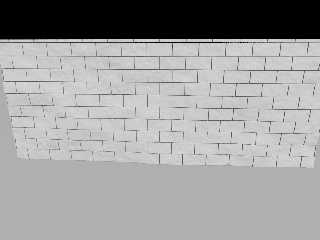 |
 |
|
 |
|
 |
|  |
|  |
|
 |
|
 |
|  |
|  |
|
 |
I'm still trying to figure out the mortar, but I managed to get a continuous
wall of bricks as a single isosurface. Unfortunately - as far as I can tell -
this method doesn't allow the random variation in the wrinkles pattern that I
get from building the wall brick by brick but it does, however, solve the
problem I was having with the max_gradient...
I guess it's a tradeoff for now.
I've been thinking that I might be able to construct a brick pattern with a
random wrinkles texture in each brick, and use that for the wall, but I'd have
to think about it a bit.
as usual, comments and suggestions are welcome.
Regards,
A.D.B.
Post a reply to this message
|
 |
|  |
|  |
|
 |
|
 |
|  |
|  |
|
 |
Sorry...
Post a reply to this message
Attachments:
Download 'workshop5.png' (328 KB)
Preview of image 'workshop5.png'

|
 |
|  |
|  |
|
 |
|
 |
|  |
|  |
|
 |
> I've been thinking that I might be able to construct a brick pattern with a
> random wrinkles texture in each brick, and use that for the wall, but I'd have
> to think about it a bit.
>
> as usual, comments and suggestions are welcome.
>
> Regards,
> A.D.B.
Have you tried Chris Hormann's Iso-CSG-Library? Such things should be possible
with his macros, even the mortar.
Best regards,
Michael
Post a reply to this message
|
 |
|  |
|  |
|
 |
|
 |
|  |
|  |
|
 |
Hmm... The trade off might be too much. What I now see is an undulating
wall which, if seen straight on, might not be a real issue, but seen
from the side, like in the image, this looks artificial.
Thomas
Post a reply to this message
|
 |
|  |
|  |
|
 |
|
 |
|  |
|  |
|
 |
Thomas de Groot <tho### [at] degroot org> wrote:
> Hmm... The trade off might be too much. What I now see is an undulating
> wall which, if seen straight on, might not be a real issue, but seen
> from the side, like in the image, this looks artificial.
>
> Thomas
TBH, I'd rather have it looking like this, than have holes in it from too low a
max_gradient.
But, like I said, I have some ideas for fixing the texture problem.
As for the Iso-csg libraries, I've heard of them, but never looked at them. At
the moment, I'm more interested in doing it myself.
Regards,
A.D.B. org> wrote:
> Hmm... The trade off might be too much. What I now see is an undulating
> wall which, if seen straight on, might not be a real issue, but seen
> from the side, like in the image, this looks artificial.
>
> Thomas
TBH, I'd rather have it looking like this, than have holes in it from too low a
max_gradient.
But, like I said, I have some ideas for fixing the texture problem.
As for the Iso-csg libraries, I've heard of them, but never looked at them. At
the moment, I'm more interested in doing it myself.
Regards,
A.D.B.
Post a reply to this message
|
 |
|  |
|  |
|
 |
|
 |
|  |
|  |
|
 |
> As for the Iso-csg libraries, I've heard of them, but never looked at them. At
> the moment, I'm more interested in doing it myself.
>
> Regards,
> A.D.B.
Yes, best way to learn things is to do it yourself. But I think that is no
reason to neglect the masters. You can even learn a lot from their codes. If you
really have combined your bricks in one isosurface than your are very close to
Chris doing I think. And to take a look at what others are (or were) doing (in
this case) cannot be wrong. I learned a lot from Chris. Look at my Rose Garden
Tunnel (especially at the bottom) I posted some months ago to the p.b.s-f.
Best regards,
Michael
Post a reply to this message
|
 |
|  |
|  |
|
 |
|
 |
|  |
|  |
|
 |
> Sorry...
>
You may be able to use the cells pattern scalled to the dimention of
your bricks, along with some repeating and offset warp, to get some
random displacement of the front of individual bricks, as well as some
variations of the shape of each faces.
You'll need to use two patterns, one "naked" cells pattern to move the
bricks slightly in and out, and one using a texture_map for the surfaces
shape variations.
Try first with only some pigments and normals to get the feel of it.
As for the mortar, it's probable that you can get away with a simple box
placed just inside of the isosurface face. A simple pigment and normal
should be enough.
If you want to go all isosurface, a simple planar one with sone high
frequency noise added will do. As almost all of it will be invisible,
you can use very low settings for the precision and to low max_gradient,
making it faster.
Alain
Post a reply to this message
|
 |
|  |
|  |
|
 |
|
 |
|  |
|
 |




![]()